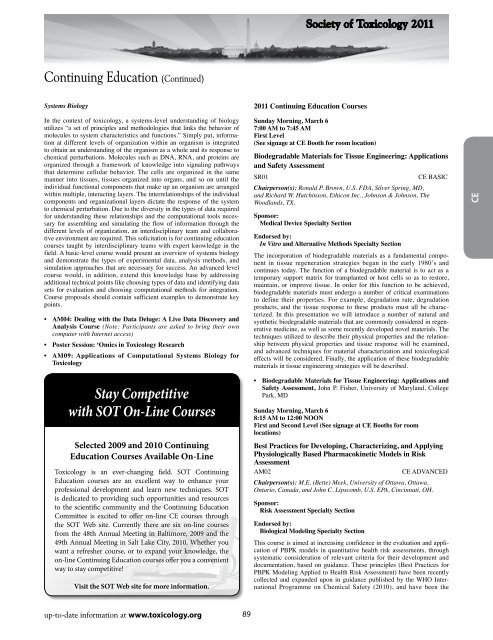Program - Society of Toxicology
Program - Society of Toxicology
Program - Society of Toxicology
You also want an ePaper? Increase the reach of your titles
YUMPU automatically turns print PDFs into web optimized ePapers that Google loves.
<strong>Society</strong> <strong>of</strong> <strong>Toxicology</strong> 2011<br />
Continuing Education (Continued)<br />
Systems Biology<br />
2011 Continuing Education Courses<br />
In the context <strong>of</strong> toxicology, a systems-level understanding <strong>of</strong> biology<br />
utilizes “a set <strong>of</strong> principles and methodologies that links the behavior <strong>of</strong><br />
molecules to system characteristics and functions.” Simply put, information<br />
at different levels <strong>of</strong> organization within an organism is integrated<br />
to obtain an understanding <strong>of</strong> the organism as a whole and its response to<br />
chemical perturbations. Molecules such as DNA, RNA, and proteins are<br />
organized through a framework <strong>of</strong> knowledge into signaling pathways<br />
that determine cellular behavior. The cells are organized in the same<br />
manner into tissues, tissues organized into organs, and so on until the<br />
individual functional components that make up an organism are arranged<br />
within multiple, interacting layers. The interrelationships <strong>of</strong> the individual<br />
components and organizational layers dictate the response <strong>of</strong> the system<br />
to chemical perturbation. Due to the diversity in the types <strong>of</strong> data required<br />
for understanding these relationships and the computational tools necessary<br />
for assembling and simulating the flow <strong>of</strong> information through the<br />
different levels <strong>of</strong> organization, an interdisciplinary team and collaborative<br />
environment are required. This solicitation is for continuing education<br />
courses taught by interdisciplinary teams with expert knowledge in the<br />
field. A basic-level course would present an overview <strong>of</strong> systems biology<br />
and demonstrate the types <strong>of</strong> experimental data, analysis methods, and<br />
simulation approaches that are necessary for success. An advanced level<br />
course would, in addition, extend this knowledge base by addressing<br />
additional technical points like choosing types <strong>of</strong> data and identifying data<br />
sets for evaluation and choosing computational methods for integration.<br />
Course proposals should contain sufficient examples to demonstrate key<br />
points.<br />
• AM04: Dealing with the Data Deluge: A Live Data Discovery and<br />
Analysis Course (Note: Participants are asked to bring their own<br />
computer with Internet access)<br />
• Poster Session: ‘Omics in <strong>Toxicology</strong> Research<br />
• AM09: Applications <strong>of</strong> Computational Systems Biology for<br />
<strong>Toxicology</strong><br />
Sunday Morning, March 6<br />
7:00 AM to 7:45 AM<br />
First Level<br />
(See signage at CE Booth for room location)<br />
Biodegradable Materials for Tissue Engineering: Applications<br />
and Safety Assessment<br />
SR01<br />
CE Basic<br />
Chairperson(s): Ronald P. Brown, U.S. FDA, Silver Spring, MD,<br />
and Richard W. Hutchinson, Ethicon Inc., Johnson & Johnson, The<br />
Woodlands, TX.<br />
Sponsor:<br />
Medical Device Specialty Section<br />
Endorsed by:<br />
In Vitro and Alternative Methods Specialty Section<br />
The incorporation <strong>of</strong> biodegradable materials as a fundamental component<br />
in tissue regeneration strategies began in the early 1980’s and<br />
continues today. The function <strong>of</strong> a biodegradable material is to act as a<br />
temporary support matrix for transplanted or host cells so as to restore,<br />
maintain, or improve tissue. In order for this function to be achieved,<br />
biodegradable materials must undergo a number <strong>of</strong> critical examinations<br />
to define their properties. For example, degradation rate, degradation<br />
products, and the tissue response to these products must all be characterized.<br />
In this presentation we will introduce a number <strong>of</strong> natural and<br />
synthetic biodegradable materials that are commonly considered in regenerative<br />
medicine, as well as some recently developed novel materials. The<br />
techniques utilized to describe their physical properties and the relationship<br />
between physical properties and tissue response will be examined,<br />
and advanced techniques for material characterization and toxicological<br />
effects will be considered. Finally, the application <strong>of</strong> these biodegradable<br />
materials in tissue engineering strategies will be described.<br />
CE<br />
Stay Competitive<br />
with SOT On-Line Courses<br />
Selected 2009 and 2010 Continuing<br />
Education Courses Available On-Line<br />
<strong>Toxicology</strong> is an ever-changing field. SOT Continuing<br />
Education courses are an excellent way to enhance your<br />
pr<strong>of</strong>essional development and learn new techniques. SOT<br />
is dedicated to providing such opportunities and resources<br />
to the scientific community and the Continuing Education<br />
Committee is excited to <strong>of</strong>fer on-line CE courses through<br />
the SOT Web site. Currently there are six on-line courses<br />
from the 48th Annual Meeting in Baltimore, 2009 and the<br />
49th Annual Meeting in Salt Lake City, 2010. Whether you<br />
want a refresher course, or to expand your knowledge, the<br />
on-line Continuing Education courses <strong>of</strong>fer you a convenient<br />
way to stay competitive!<br />
Visit the SOT Web site for more information.<br />
• Biodegradable Materials for Tissue Engineering: Applications and<br />
Safety Assessment, John P. Fisher, University <strong>of</strong> Maryland, College<br />
Park, MD<br />
Sunday Morning, March 6<br />
8:15 AM to 12:00 NOON<br />
First and Second Level (See signage at CE Booths for room<br />
locations)<br />
Best Practices for Developing, Characterizing, and Applying<br />
Physiologically Based Pharmacokinetic Models in Risk<br />
Assessment<br />
AM02<br />
CE Advanced<br />
Chairperson(s): M.E. (Bette) Meek, University <strong>of</strong> Ottawa, Ottawa,<br />
Ontario, Canada, and John C. Lipscomb, U.S. EPA, Cincinnati, OH.<br />
Sponsor:<br />
Risk Assessment Specialty Section<br />
Endorsed by:<br />
Biological Modeling Specialty Section<br />
This course is aimed at increasing confidence in the evaluation and application<br />
<strong>of</strong> PBPK models in quantitative health risk assessments, through<br />
systematic consideration <strong>of</strong> relevant criteria for their development and<br />
documentation, based on guidance. These principles (Best Practices for<br />
PBPK Modeling Applied to Health Risk Assessment) have been recently<br />
collected and expanded upon in guidance published by the WHO International<br />
<strong>Program</strong>me on Chemical Safety (2010), and have been the<br />
up-to-date information at www.toxicology.org<br />
89
















